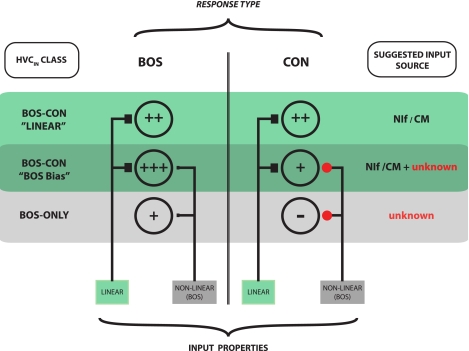Fig. 10.
Hypothetical model of how auditory inputs might shape response characteristics of HVCIN during wakefulness. Neurons showing excitatory responses to auditory stimuli fall into 2 broad categories: BOS-ONLY neurons respond selectively to BOS and often show response suppression to CON; BOS-CON neurons show excitatory responses to BOS as well as CON. Within this category, some neurons have highly linear STRFs that predict responses well to both BOS and CON stimuli (“highly linear neurons”). Other neurons have STRFs that predict responses to CON stimuli well but predict BOS responses poorly. Because these neurons respond more vigorously to BOS than they do to CON, these BOS-bias neurons are hypothesized to receive a linear input that drives the CON response and a nonlinear input that acts to boost the response to BOS. This scheme predicts that CON responses in BOS-bias neurons should be weaker than those in highly linear neurons. This trend is present in the data but does not achieve statistical significance. Likely input sources are shown on right. It should be noted that further response shaping is likely to take place within the HVC network itself, where HVCIN interact closely and reciprocally with other interneurons and both types of projection neurons (Mooney and Prather 2005). Plus symbols (+)denote gain estimates based on BOS and CON response strengths for each of the 3 classes of excitatory responders (see Figs. 3, 6C, 7C). Filled black squares represent functionally excitatory inputs. Red circles represent inputs that are functionally inhibitory. Relative size of symbols is scaled to input strength.

